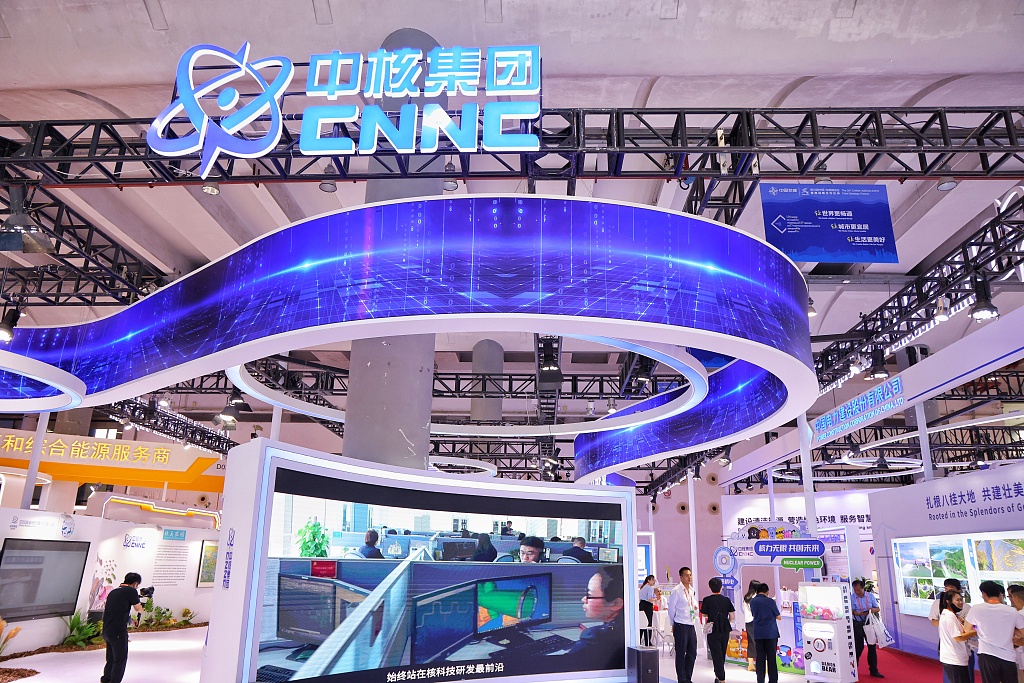
China National Nuclear Corporation displays at the 20th China-ASEAN Expo, Nanning City, southwest China's Guangxi Zhuang Autonomous Region, September 16, 2023. /CFP
China National Nuclear Corporation displays at the 20th China-ASEAN Expo, Nanning City, southwest China's Guangxi Zhuang Autonomous Region, September 16, 2023. /CFP
China and the Association of Southeast Asian Nations (ASEAN) have deepened ties in green economy, emerging as key players in fostering green transformation in recent years.
A green economy is defined as low carbon, resource efficient and socially inclusive, in which public and private investment into economic activities, infrastructure and assets will lead to economic and employment growth, according to the United Nations (UN).
These activities will allow reduced carbon emissions and pollution, enhanced energy and resource efficiency, and prevention of the loss of biodiversity and ecosystem services, it added.
According to a joint statement on China-ASEAN cooperation released in November 2022, the two sides will strengthen cooperation in developing new and emerging energy technologies, green investment and financing.
They will also promote the transition of energy and upgrading of industrial structures, thus achieving low-carbon economic development as well as green and sustainable growth.
The necessity of cooperation
China and ASEAN are the world's second and fifth largest economies respectively. With a total population of nearly 2 billion, which accounts for one fourth of the globe, there is a huge potential for increasing cooperation in green economies.
China aims to peak its carbon dioxide emissions before 2030 and achieve carbon neutrality before 2060.
According to a white paper released this year, China is endeavoring to optimize its industrial structure, promoting green production methods and practicing a green lifestyle. It also calls on all countries to join in building Earth into a global home.
ASEAN countries have also attached great importance to carbon neutrality. They've been finding ways to unlock the huge potential of the region's green transformation and pursuing carbon neutrality "with utmost urgency," according to a report on the ASEAN website.
The economic benefits of carbon neutrality would be accrued across all the member states. For example, Cambodia, Laos, Myanmar and Vietnam are projected to enjoy an increase of 9 to 12 percent of GDP by the end of the century, it added.
Cooperation in green finance
Green finance is typically regarded as a loan or investment that promotes environmentally-positive activities, such as the purchase of ecologically-friendly goods and services or the construction of green infrastructure.
In order to strengthen cooperation in green finance, China and financial institutions from Singapore and other ASEAN countries have jointly signed the Green Investment Principles for the Belt and Road.
The two sides expanded green financial cooperation through setting up branches, launching bonds and building pilot zones.
For example, the Industrial and Commercial Bank of China in Singapore launched the first Green Belt and Road Inter-bank Regular Cooperation Bonds in 2019, with a total equivalent amount of $2.2 billion.
Tutuk S.H. Cahyono, head of Bank Indonesia's Overseas Representative Office in Beijing, visited Guangzhou earlier this year, hoping to deepen green finance cooperation between the two countries, according to a report from the China Internet Information Center.

Inside a car of a train running on the China-Laos Railway, July 26, 2023. /CFP
Inside a car of a train running on the China-Laos Railway, July 26, 2023. /CFP
Cooperation in energy transition
China and ASEAN countries have been deepening cooperation in green energy transition, including in new energy vehicle (NEV) industry, railway electrification upgrades and green logistics.
Opening in December 2021, the 1,035 km China-Laos Railway, connecting Kunming in southwest China's Yunnan Province and Lao capital Vientiane, has seen more than 20 million visits and transported over 23 million tonnes of cargo as of mid-August, according to People's Daily.
Some Chinese car companies have invested in the construction of NEV production bases in Malaysia, Myanmar, Thailand and other countries, thus promoting green transformation and upgrading of the ASEAN automobile industry.
During infrastructure construction, China has been focusing on reducing interference and damage to wildlife and the environment.
China has built its largest overseas photovoltaic industry cluster in Vietnam, according to an official in China's National Development and Reform Commission.
The country has also built green and low-carbon industrial parks in various ASEAN countries and introduced green industries, creating benchmarks for green and sustainable development.